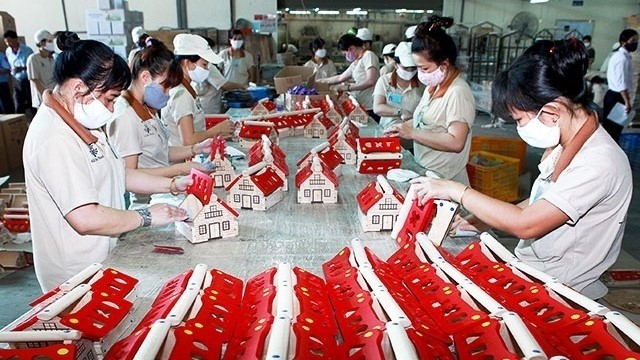Vietnam's wood and forestry product export turnover reached over US$9.3 billion in 2018, accounting for more than 23% of the agricultural sector's export value. Vietnamese enterprises have exported furniture directly to more than 120 countries and territories worldwide, topping Southeast Asia, ranking second in Asia and fifth in the world’s furniture market. It can be affirmed that the Vietnamese wood industry, after a specific period of development, has built a strong foundation for their production capacity and technological innovation, helping to gradually improve the corporate governance and earn them prestige in the international market.
Up to now, there are about 4,500 wood processing enterprises across the country, of which 95% are private. Strongly applied science and technology have become an important development resource in the wood processing industry, generating new products with new designs, meeting the increasingly selective demand, especially for products requiring high quality and fine art values.
Furthermore, businesses have paid attention to investing, researching and producing equipment, machinery and auxiliary products to replace imported ones, helping reduce dependence on foreign countries, while saving costs and improving product value and quality.
The labour force in wood processing and exporting is also increasing in both quantity and quality. Currently, there are about 500,000 wood workers in the whole country. The export market has been maintained, offering an opportunity for the wood industry to further develop.
Chairman of the Handicraft and Wood Industry Association of Ho Chi Minh City (HAWA), Nguyen Quoc Khanh, assessed that Vietnamese wood enterprises now have many opportunities to improve their competitiveness. In particular, their internal strength has been greatly improved. Enterprises are shifting management thinking towards more being professional and using intensive investment in technology to improve productivity. On the other hand, abundant human resources from a young population structure, along with the ingenuity, meticulousness and creativity of Vietnamese people are creating momentum for the wood production and processing industry to develop sustainably.
According to the Vietnam Administration of Forestry, under the Ministry of Agriculture and Rural Development (MARD), to actively bring Vietnamese wood products to the world market, local enterprises have actively enhanced trade promotion and are seeking opportunities to expand the export market. In addition, the positive effects from bilateral and multilateral free trade agreements, combined with tax incentives on multiple export and import goods, have been promising to create competitive advantages for export wood products made by Vietnamese enterprises. Regarding production materials, from the effectiveness of Vietnam’s forestry restructuring programme, so far domestic plantation forests have also met most of the demand for wood processing materials, thus reducing the proportion of imported wood, helping businesses stabilise production and build sustainable and long-term business strategies.
Despite positive results in recent years, experts also assess that the development of the wood processing industry for exports is still not adequate with its potential, with limitations and shortcomings needing to be solved to improve its capacity and sustainable development. The production capacity of the whole industry has increased continuously but its contribution is modest compared to the demand for global wood consumption, showing that the production ability of Vietnamese enterprises is still low, while the consumer market is still very large.
One of the reasons pointed out by enterprises themselves is that the quality of wood for production is not high, although timber harvested from domestic plantations has replaced more than 70% of imports. Meanwhile, outdated technologies and low labour capacity in some production facilities are also limiting the competitiveness of domestic timber enterprises. In fact, most Vietnamese wood enterprises solely produce details and parts of completed products for foreign businesses or produce wooden products under customers' samples. Not many businesses have designed their own models to offer directly to the market.
In order to improve the capacity of export wood processing enterprises, it is necessary for the State to continue researching, developing and completing mechanisms and policies, thus creating favourable legal corridors to support the wood manufacturing and processing industry, especially in the implementation of new international commitments, such as the Comprehensive and Progressive Agreement for Trans-Pacific Partnership (CPTTP) and the Voluntary Partnership Agreement on Forest Law Enforcement, Governance and Trade (VPA/FLEGT) between Vietnam and the EU.
The State should continue to remove difficulties and create an environment to promote enterprises to start businesses and expand investment, while removing difficulties and create a favourable environment for start-ups and helping enterprises expand investment, as well as limiting the export of raw material wood and developing large timber material areas with sustainable management certificates in line with international practices and criteria.
Legal enforcement agencies need to strictly control the source of imported wood and fraudulent goods origin in order to avoid taxation to protect genuine businesses. In addition, it is necessary to soon promulgate national standards and regulations on forest product processing to gradually standardise Vietnam's wood products under international standards and meeting trade defence measures, while building technical barriers to protect the export wood processing industry for domestic enterprises.
| In 2019, the country aims to earn from US$10.8-11 billion from exports of timber and forestry products, with a focus on maintaining the growth in five key markets with high export value, including the US, Japan, China, the EU and the Republic of Korea, as well as expanding market share in several potential markets in South America, Russia, Canada and India. Source: MARD |
















